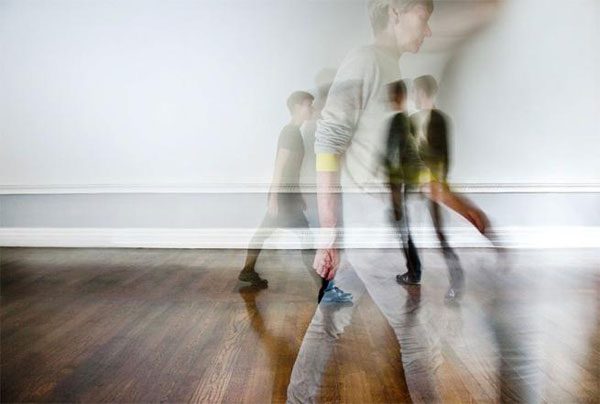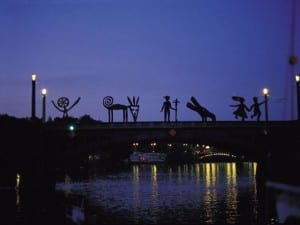Siobhan Davies has worked as a dance artist and choreographer for over 40 years and her passion for movement and communication has lead to a long and varied career. The Director of her own studios, Siobhan Davies Dance Studios, Davies can also be referred to as a performer, collaborative aritst and most recently she became involved in filmmaking. Her newest work, Table of Contents, is due to go on tour in 2014, opening at the ICA 8 January before heading onto Tramway, Glasgow and the Arnolfini, Bristol. The project reflects upon the process and difficulties of archiving dance, how memory impacts on movement and her own inquiries shared with other artists. Aesthetica speaks to Davies about her approach to the new performance and her history in dance.
A: For your new show, Table of Contents, you worked with five other dance artists and choreographers, what was the decision behind this level of collaboration?
SD: I really value that dance is often about how people are with each other and work together. I think the form is rooted deeply in the idea of passing movement from one person to another and exploring it together. To simply dance on your own is pretty isolating, because you don’t leave evidence of what you have achieved behind, whereas a painter or a musician will leave a score or an artwork. As a dancer you might construct something but afterwards, when you leave the room, you take the archive of that experience with you. It makes perfect sense for us to work together, so that we can watch one another and discuss the process of doing, undoing and trying again. I also chose to work with individuals who have collected a vast archive of experience which they want to put to use and also refine. Consequently, they all have incredible resources to work with; we question what intrigues us about movement and performance. We come from different countries and trajectories, and yet, what is communicated through movement fascinates each one of us. We gather and then we find a common interest which we want to explore now and together. We wish to maintain being independent, but within a community.
A: In Table of Contents, you break down the barriers between the artist and the audience, what is your methodology for doing this?
SD: For me, it is not necessarily about breaking down barriers – that sounds a bit physical and like the audience are trapped. Instead, we are trying to create the best circumstances for the work and the audience to meet each other. In Table of Contents we will be doing a fair amount of talking and moving at the same time. We will be discussing things we think will intrigue the audience while moving, which is not actually that easy. We’ve tested this out on a number of volunteers who have come to rehearsals and it does something to the attention of both the performer and the viewer. Another element of the work is that there is a table in the room for the audience to sit at and a performer might come over to them and ask them to watch, which in itself helps the work to be completed. I think it sets up an interesting level of exchange between people who are in the same room, whether they are a performer or member of the audience.
A: You went to art school, have you also been classically trained as a dancer?
SD: I went to the London Contemporary Dance Theatre where we basically learned the Martha Graham and the Merce Cunningham techniques, as well as several others. As we moved into bigger theatres, the directors of the company encouraged us to embrace the kind of clarity that classical ballet does. I tried my best at it – and there are principles of simplicity in the structure of ballet that I find extraordinary – but it is not the way I want to present myself. I am not drawn to classical ballet as a way of communicating movement. However, for those who do it well, it is an extraordinarily precise form of language.
A: Which performance artists have influenced you?
SD: There is an artist called William Hunt who recently performed at our studio and I’ve known his work for 10 years – his pieces have shocked me into more action. In his performances, he places himself in unpredictable situations and then he has to instantaneously deal with the consequences – it is so present and effective. I am impressed by his physical commitment to the work.
A: When choreographing a new performance, where do you draw inspiration from?
SD: I find “inspire” to be such an odd word. It almost feels a little bit religious. I become increasingly excited by the amount of possibilities that come from the reality of working with people in a particular situation. Initially, when I begin a piece, I am influenced by the performers who I am working with. The dancers are the point from which the information we are trying to express is passed over to the audience. To be really engaged with a group of dancers is wonderful because you move through the material as they are making and producing it. It is great to see a work uncover itself through a series of processes developed by all of those in the room.
A: Finally, what are your plans for the future?
SD: I made a film last year, All This Can Happen, and I want to make another one. Producing a film is an incredibly different experience; it’s another way of exposing what you don’t know. However, it is thrilling to turn around and push through it and work out what to do. Through it, I shocked myself into different ways of thinking. We are also trying to make sure that past work, such as Manual and To Hand are performed in more venues. Manual will be seen at Turner Contemporary in April. The piece involves asking a performer and one member of the audience to recognise how everyday movement is actually one of the wonders of the world.
Table of Contents, 8-19 January, ICA, 12 Carlton House Terrace, London, SW1Y 5AH.
Credits
1. Table of Contents by Siobhan Davies, with Matthias Sperling and Helka Kaski, photo by Pari Naderi.




